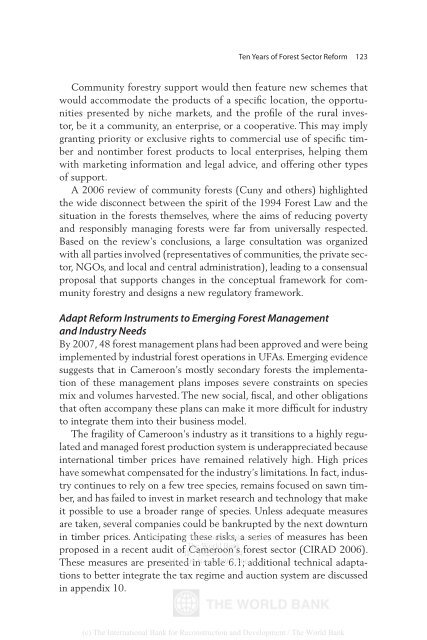The Rainforests of Cameroon - PROFOR
The Rainforests of Cameroon - PROFOR
The Rainforests of Cameroon - PROFOR
- No tags were found...
You also want an ePaper? Increase the reach of your titles
YUMPU automatically turns print PDFs into web optimized ePapers that Google loves.
Ten Years <strong>of</strong> Forest Sector Reform 123Community forestry support would then feature new schemes thatwould accommodate the products <strong>of</strong> a specific location, the opportunitiespresented by niche markets, and the pr<strong>of</strong>ile <strong>of</strong> the rural investor,be it a community, an enterprise, or a cooperative. This may implygranting priority or exclusive rights to commercial use <strong>of</strong> specific timberand nontimber forest products to local enterprises, helping themwith marketing information and legal advice, and <strong>of</strong>fering other types<strong>of</strong> support.A 2006 review <strong>of</strong> community forests (Cuny and others) highlightedthe wide disconnect between the spirit <strong>of</strong> the 1994 Forest Law and thesituation in the forests themselves, where the aims <strong>of</strong> reducing povertyand responsibly managing forests were far from universally respected.Based on the review’s conclusions, a large consultation was organizedwith all parties involved (representatives <strong>of</strong> communities, the private sector,NGOs, and local and central administration), leading to a consensualproposal that supports changes in the conceptual framework for communityforestry and designs a new regulatory framework.Adapt Reform Instruments to Emerging Forest Managementand Industry NeedsBy 2007, 48 forest management plans had been approved and were beingimplemented by industrial forest operations in UFAs. Emerging evidencesuggests that in <strong>Cameroon</strong>’s mostly secondary forests the implementation<strong>of</strong> these management plans imposes severe constraints on speciesmix and volumes harvested. <strong>The</strong> new social, fiscal, and other obligationsthat <strong>of</strong>ten accompany these plans can make it more difficult for industryto integrate them into their business model.<strong>The</strong> fragility <strong>of</strong> <strong>Cameroon</strong>’s industry as it transitions to a highly regulatedand managed forest production system is underappreciated becauseinternational timber prices have remained relatively high. High priceshave somewhat compensated for the industry’s limitations. In fact, industrycontinues to rely on a few tree species, remains focused on sawn timber,and has failed to invest in market research and technology that makeit possible to use a broader range <strong>of</strong> species. Unless adequate measuresare taken, several companies could be bankrupted by the next downturnin timber prices. Anticipating Delivered by <strong>The</strong> these World risks, Bank a e-library series to: <strong>of</strong> measures has been<strong>The</strong> World Bankproposed in a recent audit <strong>of</strong> IP <strong>Cameroon</strong>’s : 192.86.100.34forest sector (CIRAD 2006).<strong>The</strong>se measures are presented Mon, 09 in Nov table 20096.1; 17:06:18 additional technical adaptationsto better integrate the tax regime and auction system are discussedin appendix 10.(c) <strong>The</strong> International Bank for Reconstruction and Development / <strong>The</strong> World Bank
















